
Anti-aging can be tricky to figure out, especially with all the different information available online. Still, there is definitely more to staying youthful than slapping on some anti-wrinkle cream.
Anti-aging involves several strategies, which include skincare, nutrition, exercise, and even cosmetic procedures. Using a mixture of these strategies can help you stay youthful in and out. Getting cosmetic procedures can also help you get quicker results.
Skincare and Its Importance in Anti-Aging
Skincare is one of the most crucial aspects of an anti-aging regime. Your skin is usually a dead giveaway for your age, and having bad skin can make you look older. So, why is skincare crucial to looking youthful? Let’s discuss some of the proteins in our skin, including elastin, collagen, etc.
The natural aging process and environmental factors take a toll on our skin. The aging process causes functional and structural changes in extracellular matrix components (elastin, collagen, proteoglycans, etc.). Our skin needs to stay hydrated, have tensile strength, and be elastic (Huertas et al., 2016).
For instance, skin aging is usually associated with the decomposition of elastin fibers, as stated in the study made by Huertas above. Aging skin can be more pronounced in sun-exposed tissue, which is an environmental factor that can make your skin age faster. As the extracellular matrix components change and decrease, our skin will show signs of aging. The main signs of aging often show up in the skin through wrinkles, crow’s feet, less elastic skin, atrophy of the dermis, etc.

A skincare routine with anti-aging is essential because there is a decrease in cells’ proliferation in the skin’s basal layer (Makrantonaki et al., 2007). The skin also gets thinner as a person ages (Moragas et al., 1993). The epidermis gets thinner, decreasing the contact surface area between the epidermis and dermis. It causes the basal cell proliferation to become weaker, which creates a smaller exchange surface for nutrition supply to the epidermis.
Ideally, most people should start incorporating anti-aging strategies into their skin routines as early as their late 20s and early 30s. It is never too late to start a skincare routine if you are older than that, but most people will see the best results if they start earlier.
If you want an exhaustive overview of skincare, visit our skincare guide.
The Skincare Basics
The basic steps that you can follow for an anti-aging skin care routine are:
- Cleanser
- Sunscreen
- Retinol
How often you wash your face can vary. Some people may only use a cleanser at night and rinse their face in the morning. However, some people may use a cleanser once in the morning and once at night.
Most people are not going to need moisturizers except in certain situations. Your skin needs to be good at moisturizing itself without outside help. Moisturizing creams may be better for women who have dry skin and are in their 40s and above.
Some people recommend using a toner after you use a cleanser. However, that is typically done if you are using a high pH cleanser, so you may not need one if you are using a low pH cleanser. Some toners may have exfoliating properties (as mentioned below). However, you may only need to use an exfoliating toner 1-2 times a week. Otherwise, you run the risk of over-exfoliating your skin.
Retinol is the gold-standard anti-aging ingredient and has a massive amount of research backing it. You can assume that most anti-aging creams are scams unless they include some form of retinol or sun protection.
Exfoliants
Many people also recommend using a chemical exfoliant. Our skin cells’ turnover rate slows down significantly with age (Farage et al., 2013). Therefore, your skin will look uneven and dull because new cells are not replacing dead skin cells as quickly as they would when you were younger.
Exfoliants are a quick and efficient way to get rid of dead skin cells and encourage new skin cell growth. However, it would be best to skip the typical physical exfoliants (sugar scrubs, strawberry seeds, etc.) because these tend to be harsh on your skin and literally cuts it up, further worsening your skin.
There are many chemical exfoliants to choose from, and each kind will differ based on your skin type. For now, we will be looking into the best ones for anti-aging. Alpha-hydroxy acids, or AHAs for short, are ideal for maturing skin. One study proves that AHAs are an excellent way to reduce photodamage, hyperpigmentation, roughness, and sallowness (Stiller et al., 1996).
A common kind of AHA is glycolic acid, which comes from sugar cane. It is excellent for people prone to acne breakouts, who want overall exfoliation, and for preventing aging. Another example of an AHA is lactic acid. It comes from lactose in milk.
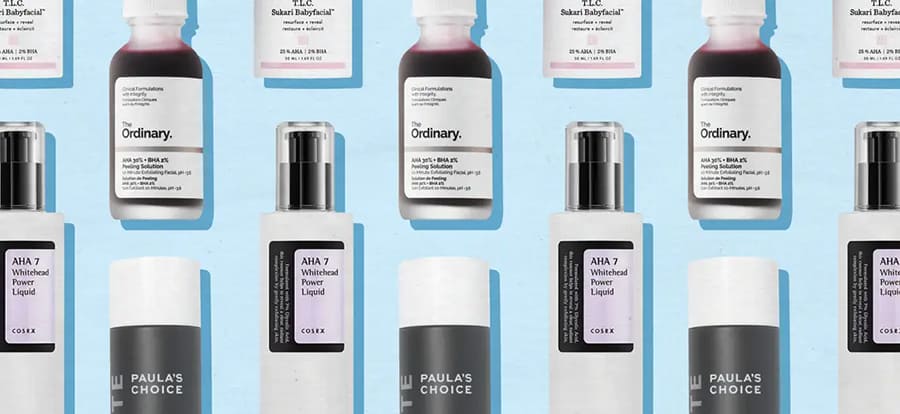
If you think a major culprit of your aging skin is sun damage, most AHAs should work for you. A notable one you could also try is tartaric acid, which helps with acne and sun damage as well.
The maximum concentration for your AHAs should be between 10-15%. Still, it may be ideal for people with sensitive skin or have not tried a chemical exfoliant to start with a much lower concentration.
Ideally, you should use an AHA exfoliant every other day before or after cleansing (refer to the instructions for your particular AHA). However, it may be best to start by using it once a week. Some people state that they use a chemical exfoliant 2-3 times a week, whereas others may even use them every day. However, most skincare experts would agree that using a chemical exfoliant 1-2 times a week should be more than enough.
Keep in mind that you must wear sunscreen daily, even if you use an exfoliant 1-2 times a week. Chemical exfoliants can make your skin more susceptible to sun damage, so wearing broad-spectrum sun protection is necessary.
Moisturizer
Moisturizing is not crucial for everyone; it mostly depends on your skin type. People with dry skin may need moisturizers. If you notice your skin is aging, you may need a moisturizer because our skin produces less sebum as it ages. Keep in mind that if you start using a moisturizer, your skin will get addicted and will no longer moisturize itself. So, you can’t stop and should be prepared to moisturize for life.
Many people opt for a light gel or water-based moisturizer in the morning before putting on their sunscreen. You may use a heavier oil or cream-based moisturizer at night.
Do not focus on labels; focus on the actual ingredients rather than the claims. Most popular anti-aging cleansers, creams, etc., may not actually have the ingredients that help delay the aging process. Instead, you should carefully look at the ingredient list and reviews to choose the right products.
An excellent ingredient to look for in an anti-aging moisturizer is retinoids, which refers to vitamin A compounds. Retinoids have great benefits for maturing skin, which include reducing fine lines and wrinkles. It can also help repair sun-damaged skin.
Some moisturizers may contain an exfoliating ingredient like AHA, even though it’s a chemical exfoliant. Usually, moisturizers that contain AHAs contain a much smaller amount than the ones sold as exfoliants. If your moisturizer has an AHA or you are already using a chemical exfoliant, be sure to use only one or the other. Using a moisturizer that has AHAs while using a chemical exfoliant can irritate your skin.
Retinol
Retinol is usually an umbrella term for topical products that have a vitamin A derivative. It is a kind of retinoid, and different variations can work at different levels. Retinol is dermatologists’ gold standard anti-aging ingredient.
Retinols, similar to AHAs and BHAs, increase collagen production and the skin’s cell turnover rate. While it offers anti-acne benefits, a major benefit that retinol offers is its anti-aging benefits. Retinol minimizes wrinkles and fine lines, and it improves the skin’s texture.
You can find retinyl palmitate and retinol in serums, eye creams, and face creams. You can find them in most drugstores, but many skincare brands offer retinol products in their skincare lines.
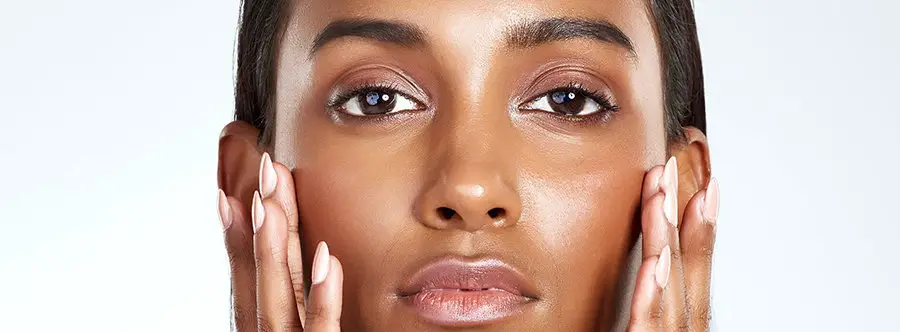
Retinyl palmitate is milder than retinol, but they are both relatively mild if you find them in a skincare product. Prescription versions like adapelene and tretinoin are much stronger, but you may not need them unless a dermatologist recommends them to you.
Most dermatologists would agree that you should avoid using prescription retinol without a prescription because it can be very irritating (Mukherjee et al., 2006).
Ideally, you should try to use retinol 1-2 times a week. If you have sensitive skin or are new to using retinol, just try it once a week first.
If you use retinol, it would probably be best to skip AHAs and BHAs. It can over-exfoliate your skin and irritate it. Watch out for certain ingredients like salicylic acid in your cleansers. It is a BHA, and pairing it with retinol can harm your skin.
Remember to use sunscreen after you use retinol.
Serums or Oils
If a moisturizer does not have a particular ingredient that you want, you can get a serum to pat gently onto your skin. Some serums will contain some of the ingredients mentioned earlier, like vitamin C.
If you want extra moisture, you can also massage a few drops of facial oil onto your hands to warm it up, then gently pat it onto your face. Some good choices for anti-aging facial oils include:
- Jojoba oil
- Frankincense oil
- Pomegranate seed oil
- Rosehip oil
- Lavender oil
You can apply serums after cleansing and toning but before your moisturizer. You can apply facial oils after you apply moisturizer.
However, we don’t recommend oils or serum because they don’t have the same amount of research backing them as retinol, and it requires extra maintenance.
Sun Protection
Chronic sun exposure leads to photoaging, a huge culprit for premature aging (Fisher et al., 2015). Sun exposure can cause long-lasting damage to the skin’s elastin and collagen. However, it is nearly impossible to avoid the sun altogether. Therefore, you need to apply sun protection on your face and body daily.
When it comes to SPF, you should aim for SPF 30 for your face and body. Of course, you can get a stronger SPF like SPF 50. However, you should know that stronger SPF does not mean that it lasts longer. An SPF 30 sunscreen and an SPF 50 will likely last for around the same time.
For example, the main difference between SPF 30 and SPF 50 is that it would take your skin 30 times longer to burn if you were using SPF 30 and 50 times longer if you were using SPF 50. However, they will likely only work for the same amount of time. Higher SPF simply shields you from more UVB rays. For instance, SPF 30 protects you from 97% of UVB radiation, whereas SPF 50 protects you from 98% of UVB radiation.
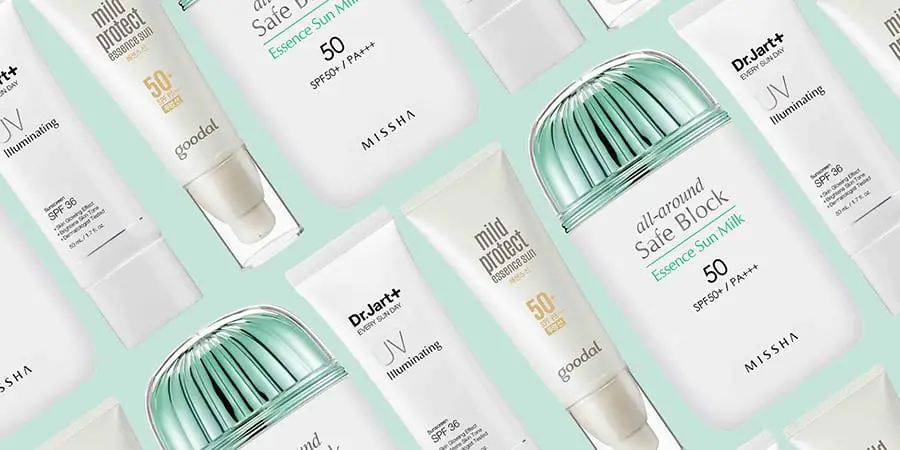
Therefore, you still need to reapply your sunscreen for at least 2-3 hours. You will also need to reapply if you swam, exercised, etc. Additionally, you must choose a broad-spectrum sunscreen. Broad-spectrum sunscreen means that it will protect you from UVA and UVB rays. If the sunscreen only mentions how much SPF it has, but it is not broad-spectrum, it will only protect you from UVB rays.
UVB rays burn your skin. However, UVA rays are a major cause of premature skin aging (age spots, wrinkling, etc.). Therefore, it would be best to choose a sunscreen that will protect you from both, especially since both kinds of UV rays can cause skin cancer.
Some sunscreens will say that they contain SPF and PA+. PA means that it offers protection from UVA rays, and seeing SPF and PA is common in Asian sunscreens.
The PA rating system works as follows:
| PA+ | Some UVA Protection |
| PA++ | Moderate UVA Protection |
| PA+++ | High UVA Protection |
| PA++++ | Extremely High UVA Protection |
It would be best to choose a sunscreen that has at least PA++.
What Ingredients You Should Not Mix
When it comes to skincare, less is more. You need to carefully analyze the ingredients of your products because some ingredients can cause a negative reaction. Here is a quick look at what you can’t mix:
Actives
A good rule of thumb to follow is not to mix too many active ingredients into your skincare routine. Active ingredients are ingredients that target specific skin concerns. Some active ingredients include:
- AHAs
- BHAs
- Hyaluronic acid
- Ceramides
- Peptides
- Niacinamide
- Vitamin C
- Vitamin E
- Retinol
Before you purchase any skincare product, make sure that the active ingredients will not clash with your current products’ active ingredients. Some examples of active ingredients you should NOT mix are:
- AHA and Retinol or Retinoids
- Vitamin C and Retinol or Retinoids
- Salicylic ACid and Retinol or Retinoids
- Vitamin C and Soap-Based cleansers
Using separate products that contain each of these products can irritate your skin. However, certain products that contain both ingredients could be great for anti-aging with minimal side effects (McDaniel et al., 2017).
It is also crucial to check whether your products contain the same active ingredients. There can be multiple kinds of the same drug, so it may take some research to ensure you are not overdoing a specific ingredient. For example, you might use a glycolic acid mask then use a cream with mandelic acid after. While they have different names, these are considered AHAs, so it would be best to choose only one.
Some people may be perfectly fine if they use several active ingredients at once. So, if you already do something similar to the example above with no irritation (redness, flakiness, stinging, etc.), you should be fine.
However, it may not be wise to try it if you have not started a skincare routine yet. Most people’s skin will find the combination too harsh, further worsening their skin.
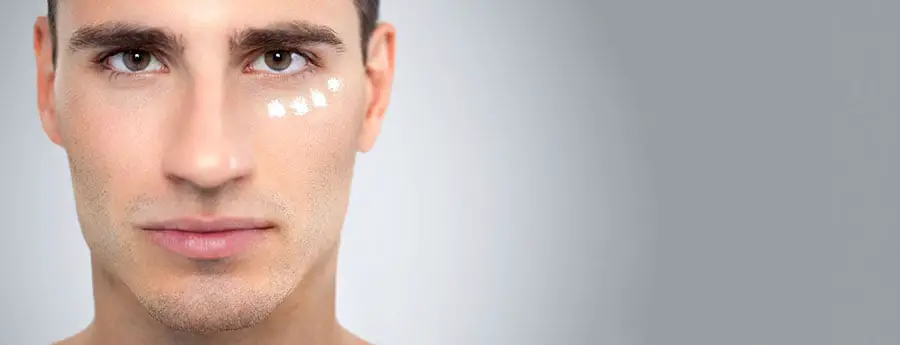
Is There a Proper Way to Do My Skincare Routine?
Most people agree that you can slightly tweak a skincare routine to suit your needs since everyone’s skin is different. However, there are some general tips you should follow.
Do Not Rub Your Face
Rubbing your face harshly, especially with a towel, cotton pad, etc., can tug and irritate your skin. Try to use a soft, clean towel or tissue to pat dry your face or let it air dry.
Cleanse For 1 Minute
Most people recommend washing your face using a cleanser for at least one minute. This allows you to get the most out of your cleanser while ensuring you clean your face well.
For more info on skincare, visit our skincare guide.
Anti-Aging for the Body
Skincare is crucial to keep our skin looking youthful, but good skincare will only go so far if you do not take care of your body from the inside. “You are what you eat” holds a lot of truth, especially when it comes to aging.
Mewing
People like to think that their bones and skull are static, unchanging. But over a timespan of years, that’s simply not true. Bones remodel at a rate of 10% in adults. Whether you like it or not, your face will age, and the natural process of craniofacial dystrophy happens to everyone:

For some of the changes that happen in the human skull with aging, check out our video on the topic:
The process of mewing attempts to combat these changes by utilizing perfect proper oral posture, which almost nobody has. It includes keeping the tongue on the roof of the mouth, lips shut, molars lightly touching, and neck/back straight. Over time, the light pressure on your upper palate will compound and change your face. One of the best examples is YouTuber AstroSky:
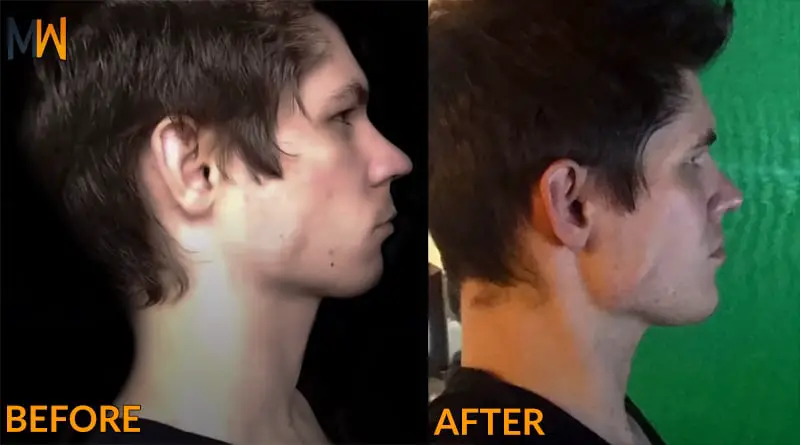
For more info on mewing, check out the scientific evidence, before/after photos, and our Ultimate Mewing Guide.
Nutrition
In truth, the importance of nutrition in skin aging is still under debate (Schagen et al., 2012). However, there is usually an obvious difference in how the skin looks if you eat a healthy or unhealthy diet. For instance, malnutrition and poor diet can make the skin look dull and dry or cause you to develop rashes.
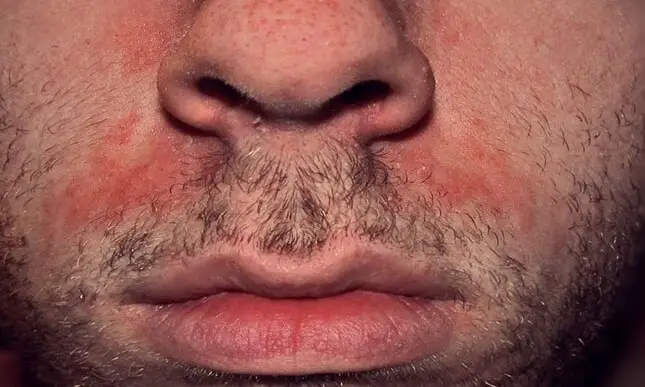
Another example is how some food can irritate and dehydrate the skin. Avoiding those triggering foods could enhance your skin.
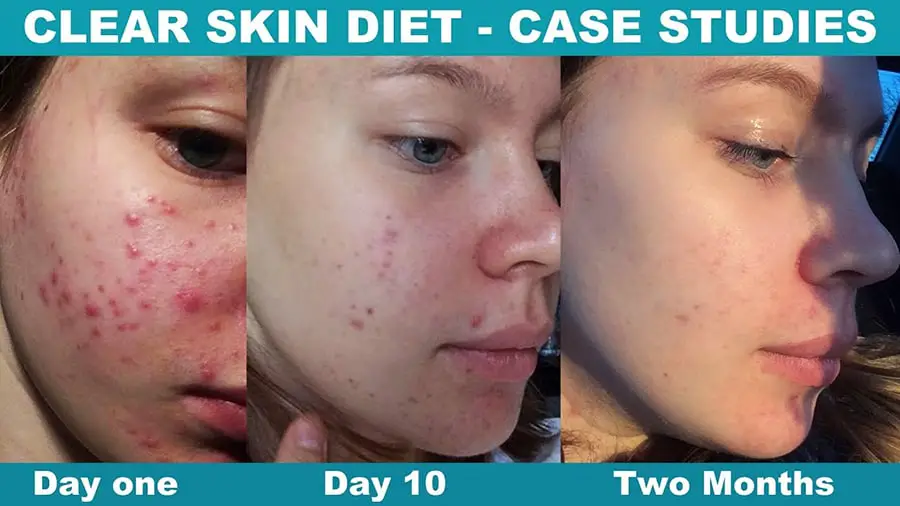
We all know the basics; eat a healthy, balanced diet. So, let’s focus on supplements/nutrients and their anti-aging properties.
Calorie Restriction
Many studies suggest that calorie deficits can help increase lifespan. One study asked the participants to do a modest calorie restriction (10% for humans) to see if it could improve cardiovascular health (Bales et al., 2014). The study found that it was likely to improve people’s heart health and prevent cardiovascular issues in obese and overweight people.
Generally, calorie restrictions can protect the body from diabetes, obesity, hypertension, cancer, etc., along with potentially increasing lifespan and improving quality of life (Weiss et al., 2011).
Weiss had another study published in the June 2008 issue of Rejuvenation Research. He found that cutting about 300-500 calories a day may slow down the aging process.
Scientists are not exactly sure why calorie deficits slow down the aging process. However, many researchers believe it lowers the body’s metabolic rate and causes the body to create less damaging free radicals. Another hypothesis is that it decreases a thyroid hormone, which then slows down tissue aging and metabolism.
So, how many calories should you cut? Ideally, you should speak to a nutritionist about this, and how much you should cut would greatly depend on your weight and health. However, most healthy individuals might be perfectly fine, cutting 200-300 calories a day.
Fasting
Fasting can also potentially prevent diseases and delay the aging process (Longo et al., 2014). There are various ways to fast, but one of the more popular methods is intermittent fasting.
Additionally, there are three kinds of fasting: calorie restriction, nutrient restriction, and seasonal eating.
Calorie restriction fasting focuses on going a certain period without food. It is usually done for 18-48 hours. You need to eat enough food before the fast starts, keep your activity levels low, and drink water once the fast starts to support your fasted state.
There are three macronutrients: fats, carbohydrates, and proteins, and the fasts usually focus on protein deloads. This kind of fast is ideal for athletes to let their guts heal. Typically, it involves eating well-cooked vegetables, carbohydrates, and high-quality fats for 2-3 days every month. Ketogenic diets (diets that cut carbs to less than 20-50 grams per day) also put your body in a semi-fasted state.
Seasonal eating is similar to how people in primal times ate in different seasons. Basically, you eat whatever would be available at that time of the year. However, this may be a more personalized diet, and it may not yield the same results as a calorie restriction fast.
A key thing to remember when you try intermittent fasting is that your eating hours should not be considered free for all to eat anything that you want. You should still focus on eating healthy food. Many people do not see results because they eat junk during their eating hours.
NAD Levels
NAD, Nicotinamide Adenine Dinucleotide, is a chemical compound that you can find in almost every cell of the body. NAD comes from Nicotinamide Riboside (ND), and the NAD levels can affect how fast or slow the aging process goes.
Typically, low NAD levels can speed up the aging process and increase the risk of Alzheimer’s disease, type 2 diabetes, and heart disease. It can also reduce agility, lead to loss of memory, and slow cognitive response. NAD levels usually decrease with age (Schultz et al., 2017).
Some natural ways to boost your NAD levels include:
- Exercise
- Nicotinamide Riboside Dietary Supplements
- Fasting
- Avoiding excessive UV exposure
- Eat foods like dairy milk, yeast, mushrooms, fish, whole grains, etc.
What Should I Eat?
Vitamin C
You can consume vitamin C through foods or supplements. The main benefit of vitamin C is that it helps make collagen (Pullar et al., 2017). Additionally, it could reduce your wrinkles and helps heal damaged skin.
Get your vitamin C from sauerkraut instead of pills. It’s in a form that’s much better for the body.
Curcumin
This compound is found in turmeric, and it is an excellent supplement to take if you want to delay age-related disease (Bielak-Zmijewska et al., 2019). Additionally, it could also alleviate age-related symptoms to help you feel youthful (Chen et al., 2018).
EGCG
ECGC, or epigallocatechin gallate, is a polyphenol found in green tea. A notable benefit of EGCG is the potential skin protection that it can provide from UV rays.
Human and animal studies both used oral and topical preparations of green tea (Oyetakin-White et al., 2012). The results found that there were significant protective effects against UV-induced skin damage.
CoQ10
Coenzyme Q10 or CoQ10 is a naturally occurring antioxidant in your body, and it protects against cellular damage and helps energy production. However, there is research that suggests CoQ10 levels decline with age.
One study focused on a group of 443 people who took CoQ10 and selenium or a placebo for four years (Johansson et al., 2015). The study found that those who took CoQ10 and selenium had fewer hospital visits, a better quality of life, and slower deterioration of mental and physical performance.
Collagen
As stated earlier, collagen helps our skin maintain its structure. However, collagen production slows down with age. Luckily, collagen supplements could go a long way.
For instance, one study looks at 72 women who took a supplement that contained 2.5 grams of collagen for 12 weeks (Bolke et al., 2019). The women had significant improvements in skin elasticity, roughness, and hydration.
It may be worth noting that the supplement contained other ingredients like biotin.
Another study with 114 women that took 2.5 grams of collagen peptides over an 8-week period also had good results (Proksch et al., 2014). The women had significant decreases in their eye wrinkles along with higher levels of skin collagen.
Exercise
Similar to nutrition, exercise is a must for anyone. Exercising can help your skin look toned and firm. Most older people tend to have saggy arms, have little muscle tone, etc., so exercising can keep that at bay.
Physical exercise is an effective way to treat and prevent the main causes of morbidity and mortality, many of which are often associated with aging (Castillo-Garzon et al., 2006). Individually adapted training programs can postpone the negative effects of aging, like mental and physical deterioration.
However, figuring out what training program is best for you may be easier said than done. Speaking to a professional trainer and doctor would give you the best idea of what training program you should follow.
Additionally, what kind of physical exercise you should do will greatly vary on your goals. For instance, yoga is good for those who want to stay flexible, calm, and build a light muscle tone. However, people who want to have very lean and ripped bodies may need to go on runs, lift weights, etc.
Surgeries to Look Younger
If you notice that you have already aged, you can always opt for a procedure instead. For instance, you can get a facelift but continue an anti-aging skincare routine to keep your skin looking plump and hydrated, enhancing your facelift results.
Some common anti-aging procedures are:
Botox
Botox injections temporarily paralyze facial muscles, making the skin look tighter and younger. It is common to get Botox injections for frown lines, crow’s feet, etc. It may be more difficult to move the treated areas, but it can be beneficial because it prevents you from worsening your wrinkles.

However, you may not see immediate effects. It may take one week to see the full effects of the Botox injections, and they usually last for 3-4 months.
Chemical Peels
As stated earlier, you can use a chemical exfoliant to get rid of dead skin cells. Your doctor can also perform a chemical peel on your face to exfoliate the skin’s outermost layer. It can make your skin brighter and remove wrinkles and age spots.
Dermabrasion and Microdermabrasion
Dermabrasion removes the skin’s outer layer using a special rotating brush. It treats sun damage, age spots, and wrinkles by removing dead skin cells and encouraging new skin cell growth.

You may experience some swelling, scabbing, and reddish/pink skin after the treatment. It may also take several weeks or months to see the final results. Most people might only need one session. However, people with more serious concerns like deep scars may need to go more than once.
Microdermabrasion uses a machine that sprays small particles onto the skin to remove the outermost layer. It is often easier to heal from this, and it is less abrasive. However, you may need more than one session to get the results that you want.
Thermage
Thermage is a treatment that stimulates collagen production, which helps tighten and lift the skin. It is ideal for people who have crepey skin, loose skin, a sagging jawline, etc.
Most people may only need one session, but it may be painful. However, some people state that they only feel stinging.
It is important to note that it may take a while to see results. Collagen takes a few months to produce, and thermage will tighten existing collagen while stimulating new collagen production. Therefore, you may only see the final result after 4-6 months. Some people may have the procedure done every 1-2 years if they want to maintain their results.
Fillers
Typically, fillers make certain features like your lips, cheekbones, chin, etc., larger. However, fillers are also a quick way to fill out lines and wrinkles in the face. Fillers are often made out of natural, gel-like ingredients injected into targeted areas to make them look plumper. Popular materials for fillers include fat, hyaluronic acid gel, and collagen.
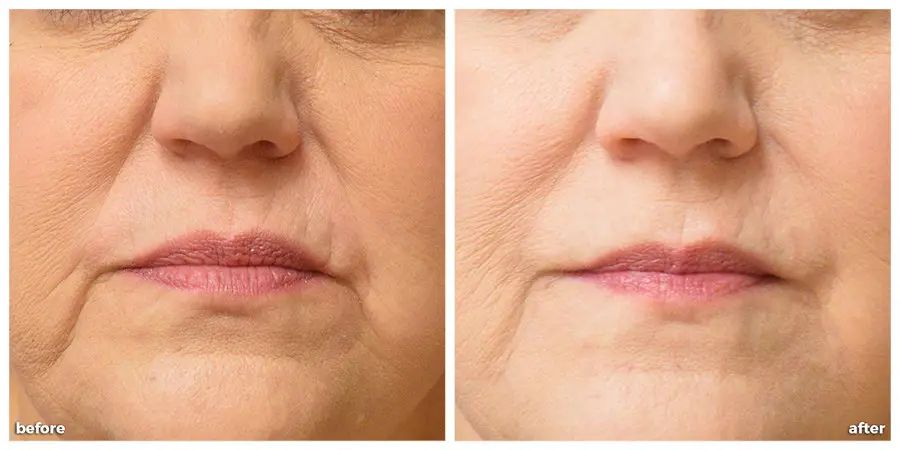
Most fillers, particularly the ones made out of natural ingredients, last for 6-12 months. However, certain materials like collagen may only last for 2-3 months. The body will metabolize the materials over time, so you will not have them forever.
However, there are semi-permanent and permanent fillers that you can get. These can last for many years, but you may need to get the fillers surgically removed if you do not want them anymore.
Facelifts
One of the most popular procedures for a youthful look is a facelift. The idea behind most facelifts is to lift the skin back and surgically alter the tissues under the skin to enhance the contour of your face.
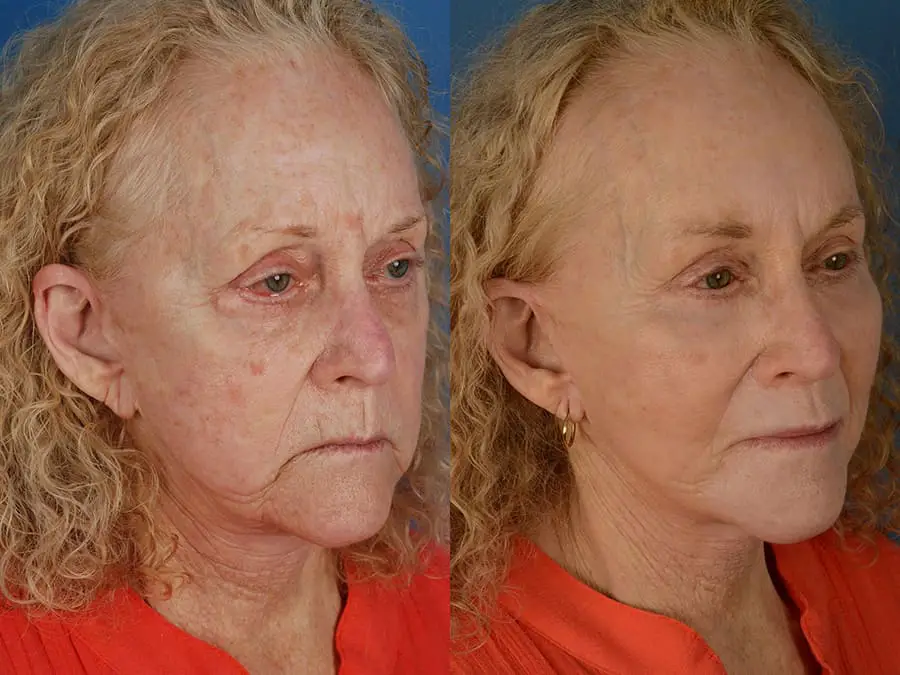
Facelifts are excellent if your primary concerns are sagging skin and saggy-looking cheeks. However, it is important to note that a facelift will not treat superficial wrinkles, creases around the upper lip and nose, sun damage, hyperpigmentation, etc.


